The total number of constructions from approved building permits increased by
31.25 percentThe province of Nueva Vizcaya total number of constructions from building permits for February 2025 was recorded at 21 constructions, 31.25 percent higher than 16 constructions in the same month of 2024.
By type of construction, the number of residential buildings and non-residential buildings were almost the same, 11 constructions and 10 constructions respectively. Construction of residential buildings between 2025 and 2024 remained constant at 11 constructions, which indicates no change. However, a significant increase was observed in non-residential buildings, rising from 5 constructions in 2024 to 10 constructions in 2025 or by 100 percent. (Figure 1)
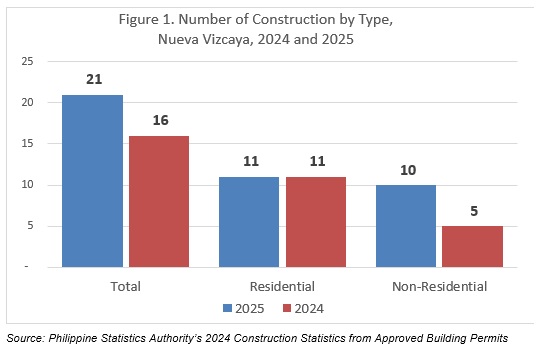
Floor area, value and average cost per square meter for residential construction decreased.
Nueva Vizcaya recorded 11 residential constructions for both years, 2024 and 2025. Despite having the same number of projects, the total floor area in 2025 (2,883 sq. m.) was slightly smaller than that of 2024 (2,988 sq. m.).
In terms of value, residential construction in 2025 amounted to PHP 35,935.40 thousand, while in 2024, it was significantly higher at PHP 46,322.70 thousand. This reflects a decrease of approximately 22.45 percent in the overall value of residential construction from 2024 to 2025.
The average cost per square meter also saw a notable drop. In 2024, the average cost was PHP 15,502.91 per square meter, whereas in 2025, it decreased to PHP 12,464.59. This represents a reduction of about 19.58 percent. (Table 1)
Table 1. Floor Area and Value of Residential Construction, Nueva Vizcaya, 2024 and 2025
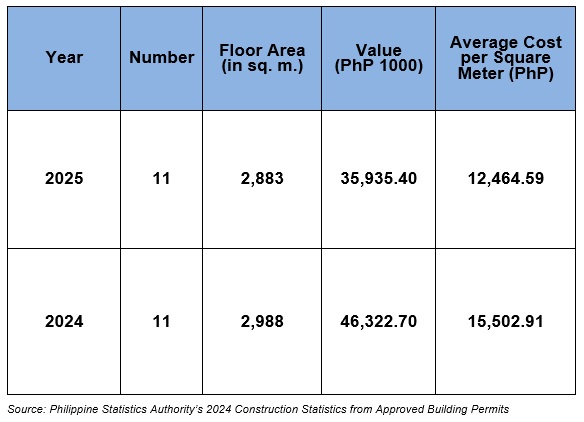
Mostly of the residential constructions are single-type houses.
For February 2025, most of residentials construction from approved building permits were single-type houses. It accounts for 90.91 percent or 10 out of the total 11 constructions. Additionally, apartment/accessoria recorded 1 construction. While there are no recorded data for duplex/quadruplex, residential condominium and other residential construction types. (Figure 2)
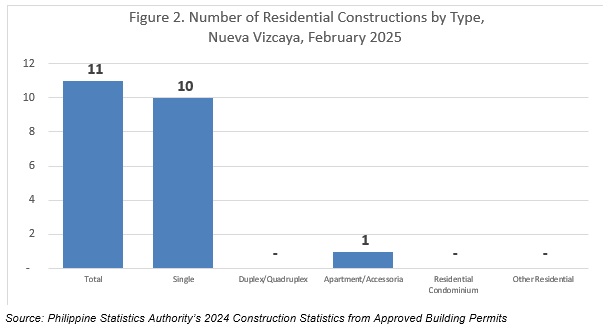
Non-residential construction’s floor area, value and average cost per square meter increased.
Non-residential construction in Nueva Vizcaya for February 2025 was tallied at 10 constructions, which doubled the 5 constructions from the same month of 2024.
Regarding floor area, non-residential constructions covered a total of 3,841 square meters in 2025, compared to only 2,022 square meters in 2024. This marks an increase of 89.97 percent. Correspondingly, the total value of non-residential construction rose from PHP 24,315.00 thousand in 2024 to PHP 48,032.00 thousand in 2025, representing an increase of 97.54 percent.
The average cost per square meter lightly increased likewise. In 2024, the cost per square meter was PHP 12,025.22, and it increased to PHP 12,505.07 in 2025, or by a growth of 3.99 percent. (Table 2)
Table 2. Floor Area and Value of Non-Residential Construction, Nueva Vizcaya, 2024 and 2025
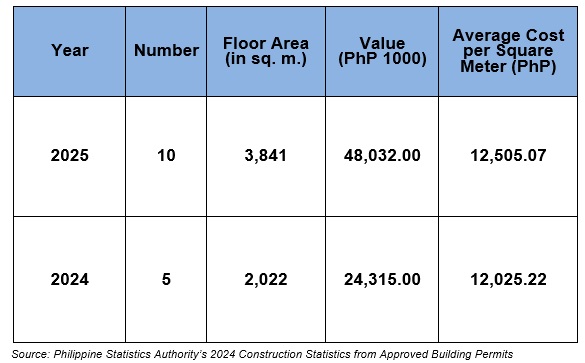
Commercial structure tops the non-residential construction.
Commercial structures have the largest number in Nueva Vizcaya’s non-residential construction having 50 percent share. Institutional buildings follow with 40 percent share and industrial buildings account for 10 percent share. Notably, there is no data tallied for agricultural and other non-residential construction. (Figure 3)
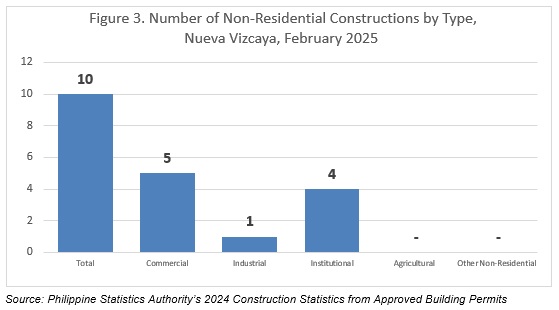
Technical Notes
The definition of term is adopted from the Revised and Updated Implementing Rules
and Regulations of the National Building Code.Building Permit is a written authorization granted by the LBO to an applicant allowing him to proceed with the construction of specific project plans after plans, specifications, and other pertinent documents have been found to be in conformity with the National Building Code.
Building refers to any independent, free-standing structure comprised of one or more rooms or other spaces, covered by a roof and enclosed with external walls or dividing walls, which extend from the foundation to the roof.
Construction refers to all on-site work done from site preparation, excavation, foundation, assembly of all the components and installation of utilities, machineries, and equipment of buildings/structures.
Residential building is a building for which its major parts or more than half of its gross floor area is built for dwelling purposes. This type of building can be of the single type, duplex, apartment and/or accessoria, and residential condominium.
Single house is a complete structure intended for a single family or household, i.e., bungalow, 2-storey house, nipa hut, etc.
Duplex house is a structure intended for two households, with complete living facilities for each; it is a single structure divided into two dwelling units by a wall extending from the floor to the ceiling.
Apartment is a structure, usually of two storeys, made up of independent living quarters, with independent entrances from internal walls and courts.
Accesoria is a one or two-floor structure divided into several dwelling units, each dwelling unit having its own separate entrance from the outside.
Residential condominium is a structure, usually of several storeys, consisting of multiple dwelling units.
Other residential construction consists of school or company staff houses, living quarters for drivers and maids, and guardhouses.
Non-residential buildings include commercial, industrial, agricultural, and
institutional buildings.
Commercial buildings refer to office buildings and all buildings which are
intended for use primarily in wholesale, retail, and service trades; i.e., stores,
hotels, restaurants, banks, disco houses, etc.
Industrial buildings are buildings used to house the production, assembly,
and warehousing activities of industrial establishments; i.e., factories, plants,
mills, repair shops, machine shops, printing press, storage plants, electric
generating plants.
Institutional buildings are buildings which are primarily engaged in providing
educational instructions and hospital/health care; ports, airports and other government buildings; i.e., schools, museums, libraries, sanitaria, churches, hospitals.
Agricultural buildings are buildings used to house livestock, plants, and agricultural products such as barns, poultry houses, piggeries, stables,
greenhouses, and grain mills.
Other non-building constructions include cemetery structures, street
furniture, waiting sheds, communication towers, etc.
Floor area of building refers to the sum of the area of each floor of the building measured to the outer surface of the outer walls including the area of lobbies, cellars, elevator shafts, and all communal spaces in multi-dwellings. Areas of balconies are excluded.
Total value of construction refers to the sum of the cost of building, electrical,
mechanical, plumbing, and other. The value is derived from the approved building permit and represents the estimated value of the building or structure when completed.
CHOLLY L. BAYON
Chief Statistical Specialist
